The effect of changing ground temperatures on the behaviour of soil and rock is an important consideration of many engineering projects. This includes during design for landfills, hydrocarbon recovery, pipelines, geothermal energy developments, pavements, and buried power cables (Gens, 2010).

Some high-value structures, such as those used for radioactive waste storage, have required investigation in recent years to determine how clay barriers will react to elevated temperatures generated by the waste. The response of geomaterials in cold regions undergoing freeze-thaw cycles can also have a significant impact on foundations and other infrastructure, and should be accounted for.
At GDS we have developed temperature control solutions for a range of our triaxial systems. These allow the effect temperature change may have on soil and rock to be observed during triaxial consolidation and shearing, with options available for testing unsaturated soils, determining small-strain parameters, and dynamically shearing the test specimens. Note the control solutions consist of heating and cooling hardware, or heating hardware only. Gaseous back pressures, such as carbon dioxide or nitrogen, may also be applied within the temperature controlled systems.

Test Standards for Temperature Controlled Testing
| Determination of the creep response of frozen soil via uniaxial compression. This response may be used to assess the long term stability of structures constructed within permafrost, as well as assist with the design for shallow and deep foundations. |
| Determination of the compressive strength and elastic moduli of rock cores, under varying stresses and temperatures, via the triaxial apparatus. The compressive strength may be used within many design formulas, with the elastic moduli enabling the stress or deformation within a rock mass to be calculated.
|
| Determination of the creep response of rock cores, under constant stress and temperature, via the triaxial apparatus. This response may be used to assess the long term stability of structures constructed within rock masses.
|
| Determination of the strength of frozen soil via constant rate of strain compression. This response may be used to assess the medium to long term stability of structures constructed within permafrost, as well as assist with the design for shallow and deep foundations.
|
Products for Temperature Controlled Testing
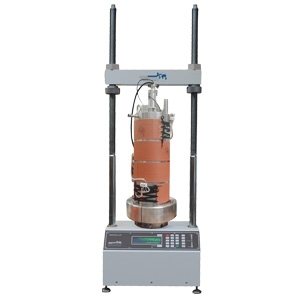
| ETAS – EnvironmentalTriaxial Automated System The environmental triaxial automated system (ETAS) is based on the standard GDSTAS, with a high pressure triaxial cell and heating/cooling system included. The temperature system is automatically controlled alongside the regular triaxial system components via software, with the full range of triaxial test software modules available for use with the HPETAS. Upgrade options can also be specified, including the addition of bender elements, hardware for unsaturated soil testing, and local strain transducers. |
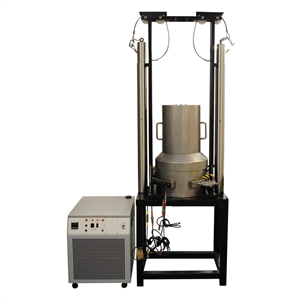
| ETTS – Environmental Triaxial Testing System The high pressure environmental triaxial testing system (ETTS) is based on the standard GDSTTS, with a high pressure Bishop and Wesley style cell and heating/cooling system included. The temperature system is automatically controlled alongside the regular triaxial system components via software, with the full range of triaxial test software modules available for use with the ETTS. Upgrade options can also be specified, including the addition of bender elements, hardware for unsaturated soil testing, and local strain transducers. |
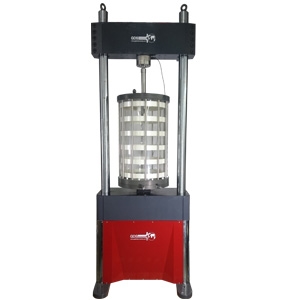
|
The GDS Virtual Infinite Stiffness loading system (GDSVIS) is the premier load frame in the GDS range with load capacities of 250kN to 400kN. The GDSVIS load frames are designed to be stiffer than classical loading frames. This is to allow more accurate testing of stiffer specimens with less equipment compliance. Furthermore each GDSVIS is internally calibrated to allow automatic self-compensation for any remaining compliance. This type of frame is exclusive to GDS. When combined with a triaxial cell, pressure/volume controllers, data acquisition, and temperature control system, the GDSVIS enables the response of soil and rock under frozen and/or heated conditions to be observed and quantified. |
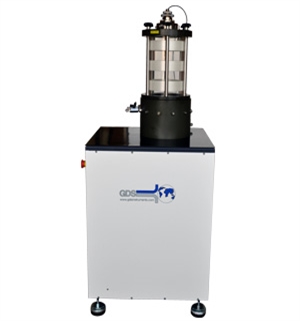
|
The Advanced Dynamic Triaxial Testing System is a high-end, no compromise testing apparatus combining a triaxial cell with a dynamic actuator capable of applying load, deformation and stresses up to 10Hz. The cell itself is screw-driven from an integral base unit housing the motor drive. Axial force and axial deformation are applied through the base of the cell. The system can be combined with a dynamic cell pressure actuator such that cell pressures may also be applied dynamically up to fundamental frequency of the machine (i.e. 2Hz, 5Hz or 10Hz). Additionally the DYNTTS may be upgraded to include a temperature control system, enabling the dynamic cyclic response of soil to be observed and quantified when placed under frozen and/or heated conditions. |
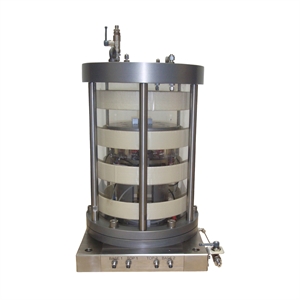
|
For many years the resonant column apparatus has been used in research and commercial laboratories to estimate values of the shear modulus, G, and damping ratio, D, for soil specimens across the small to medium strain range (< 1 %). The variation in these parameters with increasing strain magnitude allows engineers to conduct dynamic response analyses, such as those using finite element and non-linear analytical methods, which enable performance assessment of natural and engineered structures subjected to dynamic and cyclic loadings. With a temperature control system upgrade, the GDSRCA can also determine G and D curves for frozen and heated specimens, enabling dynamic analyses for soils under extreme temperature conditions to be conducted. |
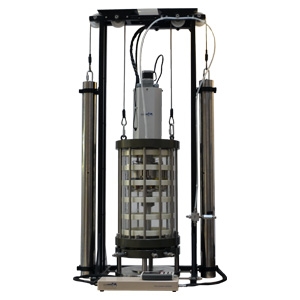
|
Hardin Type Resonant Column Apparatus (HARRCA) is a system that allows specimens to be tested in resonance while maintaining an anisotropic loading. This is achieved by a slender, thin walled loading column passing through the drive system to the top-cap. The GDS Hardin style oscillator contains an electro-magnetic drive system incorporating precision wound coils and composite sintered neodymium iron boron (NdFeB) “rare-earth” magnets. The apparatus can be mounted in a stand-alone system with an integral axial force actuator, or as a cell for integration into an existing load frame. With a temperature control system upgrade, the HARRCA can determine G and D curves for frozen and heated specimens, enabling dynamic analyses for soils under extreme temperature conditions to be conducted. |
Relevant GDSLAB Test Modules for Temperature Controlled Testing
HPETAS: - Saturation and consolidation
- K0 consolidation
- Permeability
- Standard displacement-controlled triaxial loading
- User-defined stress paths
- Advanced triaxial loading
| HPETTS: - Saturation and consolidation
- K0 consolidation
- Permeability
- Standard displacement-controlled triaxial loading
- User-defined stress paths
- Advanced triaxial loading
|
Product Applications